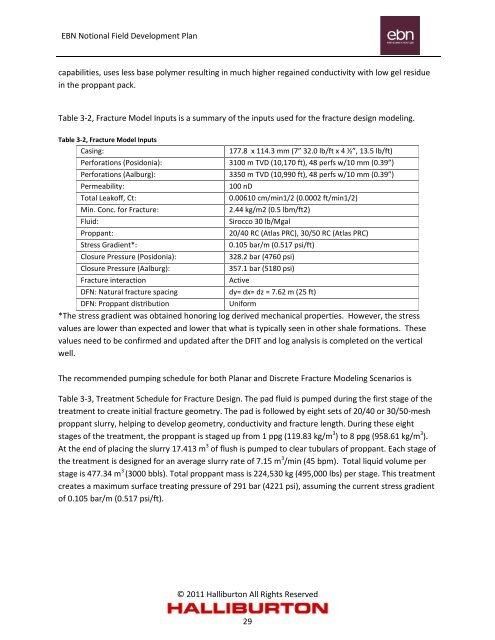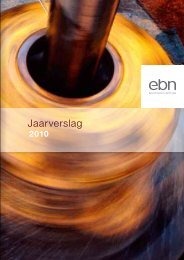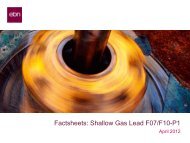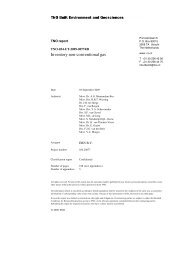Notional Field Development Final Report - EBN
Notional Field Development Final Report - EBN
Notional Field Development Final Report - EBN
Create successful ePaper yourself
Turn your PDF publications into a flip-book with our unique Google optimized e-Paper software.
<strong>EBN</strong> <strong>Notional</strong> <strong>Field</strong> <strong>Development</strong> Plan<br />
capabilities, uses less base polymer resulting in much higher regained conductivity with low gel residue<br />
in the proppant pack.<br />
Table 3-2, Fracture Model Inputs is a summary of the inputs used for the fracture design modeling.<br />
Table 3-2, Fracture Model Inputs<br />
Casing:<br />
177.8 x 114.3 mm (7” 32.0 lb/ft x 4 ½”, 13.5 lb/ft)<br />
Perforations (Posidonia): 3100 m TVD (10,170 ft), 48 perfs w/10 mm (0.39”)<br />
Perforations (Aalburg): 3350 m TVD (10,990 ft), 48 perfs w/10 mm (0.39”)<br />
Permeability:<br />
100 nD<br />
Total Leakoff, Ct:<br />
0.00610 cm/min1/2 (0.0002 ft/min1/2)<br />
Min. Conc. for Fracture:<br />
2.44 kg/m2 (0.5 lbm/ft2)<br />
Fluid:<br />
Sirocco 30 lb/Mgal<br />
Proppant:<br />
20/40 RC (Atlas PRC), 30/50 RC (Atlas PRC)<br />
Stress Gradient*:<br />
0.105 bar/m (0.517 psi/ft)<br />
Closure Pressure (Posidonia):<br />
328.2 bar (4760 psi)<br />
Closure Pressure (Aalburg):<br />
357.1 bar (5180 psi)<br />
Fracture interaction<br />
Active<br />
DFN: Natural fracture spacing<br />
dy= dx= dz = 7.62 m (25 ft)<br />
DFN: Proppant distribution<br />
Uniform<br />
*The stress gradient was obtained honoring log derived mechanical properties. However, the stress<br />
values are lower than expected and lower that what is typically seen in other shale formations. These<br />
values need to be confirmed and updated after the DFIT and log analysis is completed on the vertical<br />
well.<br />
The recommended pumping schedule for both Planar and Discrete Fracture Modeling Scenarios is<br />
Table 3-3, Treatment Schedule for Fracture Design. The pad fluid is pumped during the first stage of the<br />
treatment to create initial fracture geometry. The pad is followed by eight sets of 20/40 or 30/50-mesh<br />
proppant slurry, helping to develop geometry, conductivity and fracture length. During these eight<br />
stages of the treatment, the proppant is staged up from 1 ppg (119.83 kg/m 3 ) to 8 ppg (958.61 kg/m 3 ).<br />
At the end of placing the slurry 17.413 m 3 of flush is pumped to clear tubulars of proppant. Each stage of<br />
the treatment is designed for an average slurry rate of 7.15 m 3 /min (45 bpm). Total liquid volume per<br />
stage is 477.34 m 3 (3000 bbls). Total proppant mass is 224,530 kg (495,000 lbs) per stage. This treatment<br />
creates a maximum surface treating pressure of 291 bar (4221 psi), assuming the current stress gradient<br />
of 0.105 bar/m (0.517 psi/ft).<br />
© 2011 Halliburton All Rights Reserved<br />
29







